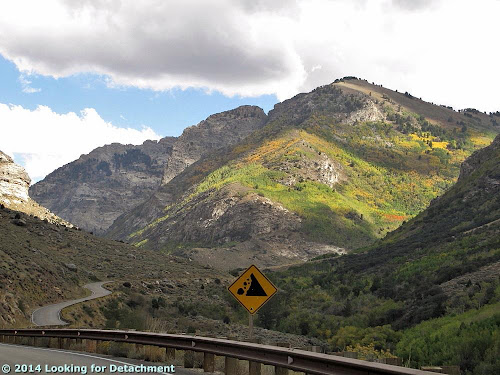Would you believe...a geologist living mostly in Nevada since 1975, who had never been into the Ruby Mountains until two weeks ago? One who had been over Secret Pass several times and down Ruby Valley once, but never
into the mountains?
One reason to go to Lamoille Canyon, if you've never been there, is the excellent scenery. Another reason would be the excellent geology...including geology related to the metamorphic core complex that makes up the Ruby Mountains — along with several, and more than one type, of low-angle faults — and also geology related to the Pleistocene glaciation of the mountains.
 |
Terminal moraine of Lamoille Canyon,
beyond the field that happens to be part of an outwash plain. |
The photo above wasn't our first view of Lamoille Canyon, when MOH and I visited about two weeks ago on our way to the
NMEC 2nd Annual GBR. That photo is from the second day's morning field trip to see some of the glacial geology of the Rubys (or would that be Rubies?), led by
Dr. Mike McFarlane. Instead, our first view of the canyon was as pictured below:
 |
| Looking into Lamoille Canyon from just before the entrance to the Ruby Dome Ranch (Google Maps location). |
Unnamed hill 9942 forms the flattish-looking knob just right of center, and although it's hard to tell for sure, even from repeated viewings in Google Earth, the jagged knobs in the distance on the left appear to be Ruby Spire at 10,835 ft on the far left, the Wolf's Ear at 10,788 in the center, and an unnamed peak at 10,835 ft on the right (seemingly lower because it's behind the other two jagged knobs). I've gleaned the names Ruby Spire and Wolf's Ear from Panoramio and Google Earth photos rather than from USGS topo maps of the area, suggesting to me that at least some of the supposedly unnamed peaks and knobs of the Rubys may have names known by the locals and other frequenters of the area.
 |
Another view looking into the first part of Lamoille Canyon,
this time from the 2nd day. |
With these first views of the canyon, the valley appears to be dominantly V-shaped: the overall U-shape of the valley has been modified by the post-glacial down-cutting of Lamoille Creek.
 |
| At this point, where a falling rock sign appears on the side of the road, the overall U-shaped nature of the glacially carved canyon can be seen. |
The main part of Lamoille Canyon forms the foreground right of the road and highway sign, and it continues to the far left where cliffs of brownish gneiss, marble, and granite abound. The Right Fork of Lamoille Creek shoots off to the right, into the U-shaped canyon where its eastern, sunlit slopes are covered by green, yellow, and orange aspen trees.
The GBR was located at Camp Lamoille (AKA Lion's Camp Lamoille or the Boy Scout Camp), nestled in a flat area along Right Fork Lamoille Creek (or South Fork Lamoille Canyon). Photos of the area shown below are from Days 1 and 2 of the three-day outing.
 |
Looking south up the South Fork of Lamoille Canyon. Back in the rocky section of the canyon, Ruby Spire and the Wolf's Ear are on the left;
Mt. Gilbert is on the right. |
 |
| This photo is centered on a lateral moraine of South Fork Lamoille Canyon, which blocked the main canyon (to the left) and has been breached by Lamoille Creek. |
In the photo above, besides the breached lateral moraine, the upper portion of a couloir called "Terminal Cancer" can be seen on the far left. Ruby Spire (
Google Maps location) is in the center distance (highest spire of the jagged ridge on the east side of the Right Fork of Lamoille Creek. The Wolf's Ear (
Google Maps location) forms the center of that jagged ridge.
 |
| We've arrived in camp. The Wolf's Ear is still visible as the highest jagged knob near the center of the photo. |
 |
| Rapidly changing lighting at Camp Lamoille. |
 |
| Wolf's Ear is on the left (east side of the South Fork canyon). Mt. Gilbert is the tallest peak on the right. |
 |
| Our campsite below the cliffs. You can see in this photo the very minimal spots of snow below Mt. Gilbert, fairly unusual in the Rubys for late September. |
 |
| A closer view of the Wolf's Ear. |
 |
| Looking up the same canyon from one of the trails near the beaver ponds. |
 |
| An even closer view of the Wolf's Ear (dark knob on the left), taken on the stormy second day. |
 |
| Another view of the South Fork of Lamoille Canyon, taken during a downpour featuring multiple hail events and (later) lightning directly overhead. |
Camping in the stormy weather of two weeks ago was fascinating. The overall camping experience, which could have been a disaster, was mitigated by the presence of a wood-heated lodge or dining area, and abundant free food and drinks.


















































